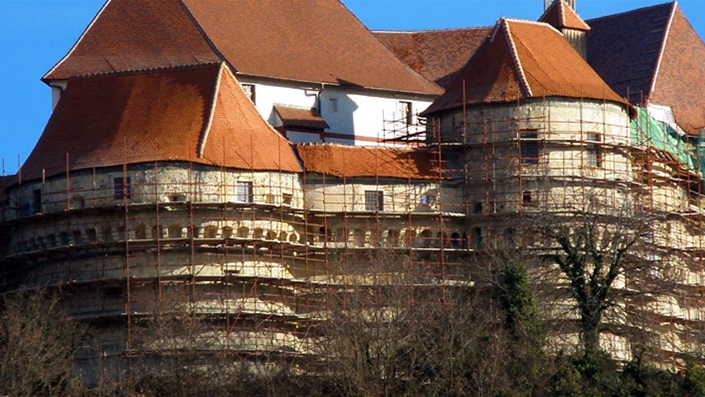Conservation and restauration work
While the most urgent work on the most dilapidated parts of Veliki Tabor was occasionally done in the course of the 20th century, the first systematic conservation research headed by the Croatian Conservation Institute and financed by the Ministry of Culture of the Republic of Croatia began in the mid-1990s, when the Veliki Tabor castle and the courtyard porches were researched.
The Tuscan pillars (ground floor, first floor, and second floor) and hence the courtyard porches were reconstructed and restored in the period between 2001 and 2005. In the autumn of 2007, the completion of the conservation work on the façade and in the interior of the castle marked the completion of the first stage of the restoration of the oldest part of Veliki Tabor, which was opened to the public with an exhibition entitled, Veliki Tabor u Svjetlu Otkrića [Veliki Tabor in the Light of Discovery]. In the first nine months of 2008, over 25,000 visitors toured Veliki Tabor, which testifies to the great public interest in the fort.
In late 2008, the second stage of reconstruction was launched with continued conservation research and work on the façades of all the Renaissance towers and curtain walls, reconstruction of all the roof areas, and comprehensive reconstruction. Veliki Tabor was again closed for visitors in view of the extensive work.
In addition to the comprehensive reconstruction work, multidisciplinary research was conducted, the results of which, along with proposed presentation and reconstruction guidelines, were presented by the Croatian Conservation Institute in three feasibility studies totalling eight tomes.
Once the second stage of reconstruction of Veliki Tabor was completed in late 2011, the working areas of Veliki Tabor museum and the museum's storage facility were operational. On 13 November 2011 visitors were again allowed in Veliki Tabor to see exhibitions in the Late Gothic castle, while the interior of the Renaissance towers has yet to be populated with exhibits.
Parallel with reconstruction, archaeological research of the ground floor of the semi-circular towers, archaeological supervision of some of the digs in the vicinity of Veliki Tabor, and research of certain parts of the outer defence ring (south and north guardhouses, test probe in the bastion, and the entrance tower at the bastion) were conducted. The research results include exceptionally valuable archaeological finds (from determining certain parts of the architecture to numerous examples of Late Mediaeval ceramics). It was on the basis of the many unearthed fragments of ceramic stoves that three Renaissance ceramic stoves from Veliki Tabor were reconstructed and restored.
